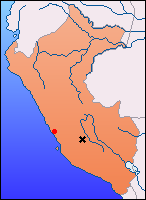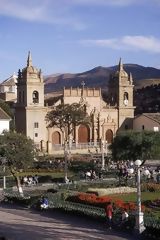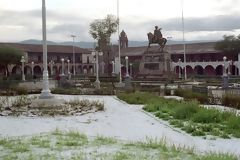 |
Related pages: |
 In the Pikimachay cave, located in the Ayacucho region, evidence of human presence dating back to 20,000 BC was discovered. These archaeological findings highlight the long history of human settlement in this part of The Andes. Between the 6th and 7th centuries, the first major Andean culture, the Wari culture, flourished here, with its capital located in the Ayacucho region. The Wari were known for their advanced political organization and their influence over much of the Peruvian coast and highlands.
In the Pikimachay cave, located in the Ayacucho region, evidence of human presence dating back to 20,000 BC was discovered. These archaeological findings highlight the long history of human settlement in this part of The Andes. Between the 6th and 7th centuries, the first major Andean culture, the Wari culture, flourished here, with its capital located in the Ayacucho region. The Wari were known for their advanced political organization and their influence over much of the Peruvian coast and highlands.
After the collapse of the Wari Empire in the 10th century, a powerful regional state emerged: the Chanka. The Chanka fiercely resisted the Incas before eventually being conquered. Following this conquest, the region became an important administrative center for the Inca Empire, with Vilcashuaman serving as the provincial capital, a prosperous city where Inca nobility and local inhabitants coexisted.
 After the Spanish conquest, settlers founded the city of San Juan de la Frontera in 1540. The city's name was later changed to San Juan de la Victoria in 1542 following the Spanish victory at the Battle of Chupas. However, the traditional name Huamanga continued to be used by the local population. This Quechua name, meaning "place of stone," refers to the rocky hills surrounding the city.
After the Spanish conquest, settlers founded the city of San Juan de la Frontera in 1540. The city's name was later changed to San Juan de la Victoria in 1542 following the Spanish victory at the Battle of Chupas. However, the traditional name Huamanga continued to be used by the local population. This Quechua name, meaning "place of stone," refers to the rocky hills surrounding the city.
On February 15, 1825, Libertador Simón Bolívar renamed the city Ayacucho to commemorate the Battle of December 9, 1824, a decisive battle that sealed Peru's independence and the end of Spanish colonial rule in South America. This battle, fought on the high plains of Ayacucho, is one of the most glorious moments in Peruvian history.
Ayacucho is one of the few cities in Peru that has preserved its colonial architecture almost intact. Walking through its cobblestone streets, you'll feel as though you've stepped back in time, surrounded by colonial houses, grand churches, and charming plazas. The peaceful atmosphere of the city contrasts with its tumultuous history. Visitors can admire the many churches and historic buildings that showcase the grandeur of the colonial era.
Ayacucho is renowned for its 33 colonial churches, each with a unique style and history. Among the most notable are the La Compañía Church and the Ayacucho Cathedral, located on the Plaza de Armas. These religious buildings, with their ornate facades and richly decorated interiors, are testament to the city's prosperous past.
In addition to its architectural treasures, Ayacucho is a city of living culture. Each year, the city hosts Semana Santa, one of the most important religious celebrations in the country, attracting visitors from all over the world. The streets come alive with religious processions, traditional dances, and artisan markets. Ayacucho's cultural richness is also reflected in its craftsmanship, particularly in the creation of retablos, small, hand-carved and painted scenes.
Ayacucho is a must-visit destination for history, architecture, and culture enthusiasts. From its prehistoric remains and Inca heritage to its colonial treasures, it offers a fascinating journey through Peru's history. Whether you're passionate about archaeology or simply seeking a change of scenery, Ayacucho will captivate you with its timeless charm and deeply rooted traditions.